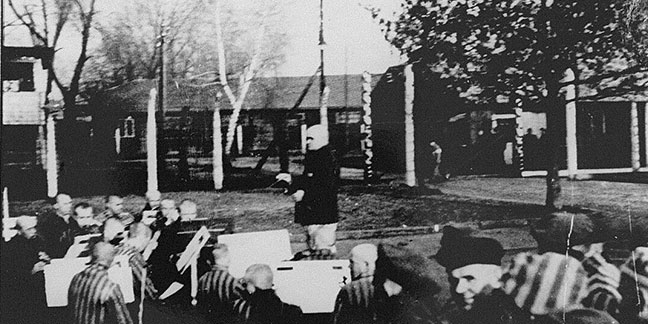Music amid death
 Music composed during World War II encompasses an extraordinary amount of works spanning the globe, from the Seventh Symphony (the “Leningrad”) of Dmitri Shostakovich to Olivier Messiaen’s “Quartet for the End of Time,” but music played by concentration camp orchestras may be the most poignant and heartbreaking.
Music composed during World War II encompasses an extraordinary amount of works spanning the globe, from the Seventh Symphony (the “Leningrad”) of Dmitri Shostakovich to Olivier Messiaen’s “Quartet for the End of Time,” but music played by concentration camp orchestras may be the most poignant and heartbreaking.
Several prominent Jewish composers and musicians persecuted by the Nazi regime fled Europe, but many were imprisoned and/or murdered in the concentration camps. A small few were able to survive by playing in musical ensembles.
This month, the Church celebrates the feast of two saints who perished in Auschwitz: St. Maximilian Kolbe (1894-1941) and St. Edith Stein, also known as St. Teresa Benedicta of the Cross (1891-1942). It is nearly certain both heard the orchestral ensembles there before their executions. (Worth noting also is the recently canonized St. Titus Brandsma (1881-1942), a priest murdered in Dachau, whose feast day is July 27.)
Auschwitz housed two separate “Lagerkapellen” (camp orchestras) – one each for men and women. Unlike the men’s orchestra, which was comprised primarily of professional musicians, the “Mädchenorchester” was mainly amateurs. The women were not assigned to a work detail because their time was dedicated to rehearsing under their primary conductor, fellow inmate and acclaimed violinist Alma Rosé, the niece of Gustav Mahler.
Cellist Anita Lasker-Wallfisch has spoken extensively of her time in the orchestra. In numerous interviews, she explains that the ensemble’s location was Block 12, near a crematorium. The music was clearly audible by the new arrivals as well as those directed towards the gas chambers – likely the music St. Teresa Benedicta heard in her final hours. One of Lasker-Wallfish’s most well-known stories is a personal request by Dr. Josef Mengele, the “Angel of Death,” for “Träumerie” from Robert Schumann’s “Kinderszenen.”
The men’s orchestra played light German marches while the other male prisoners were marched out to work details. Because they were professional musicians, they did not have extensive rehearsal time and following the morning procession, they, too, were sent on work details. Undoubtedly during St. Maximilian Kolbe’s short time in Auschwitz, he heard this ensemble in this capacity each morning and evening. Less likely to be heard were the weekly Sunday concerts, which were reserved for guards and high-ranking inmates.
Szymon Laks, a composer and violinist, published his experiences in the “Auschwitz Orchestra in Music of Another World.” Laks was eventually saved from work detail when he became a “Notenschrieber” (music copyist). Later, he became the conductor of the orchestra. In his writing, he explains the difficulty in arranging music for an ensemble that was consistently changing due to severe illness, gassing or suicide. Another challenge, according to Laks, was communication between musicians since the personnel spoke numerous languages.
Oftentimes, it is assumed that music brought great comfort and brief respites from the horror of camp life. While this may have been somewhat true for the musicians, the players of both ensembles state this was not the case for the other inmates. In “Children of the Flames,” Judith Yagudah, a Hungarian twin experimented on by Mengele, recalled “Mengele took us to a concert once. I still remember it – because it was so awful. It was held just outside our compound.
The orchestra was made up entirely of women prisoners. Listening to them play was heartbreaking. It reminded us so much of normal life ... the life we’d had before ... the life that other people still led.”
Yagudah survived the Holocaust but for other countless souls, these orchestral pieces were the last music they would hear on earth.
While reflecting on the lives of Sts. Maximilian and Teresa Benedicta, the latter’s words remain timeless: “Each finite creature can reflect only a fraction of the divine nature; thus, in the diversity of His creatures, God’s infinity, unity and oneness appear to be broken into an effulgence of manifold rays.” She reminds the faithful to truly love our neighbor – not in spite of our diversity, but because of it.
— Christina L. Reitz
Pictured: An undated photo of a prisoners’ orchestra during a Sunday concert for the SS guards at Auschwitz. The orchestra was probably conducted by the inmate Franciszek Nierychlo. (Photo courtesy of Music and the Holocaust)
Learn more
At www.holocaustmusic.ort.org: Learn more about music during the Holocaust, including original works, talented composers and artists, and the memory of concentration camp orchestras
Listen online
Listen to a piano performance of “Träumerie” from Robert Schumann’s “Kinderszenen”


